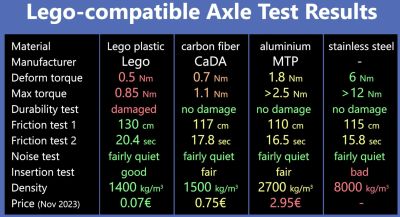If you ever wondered what’d happen if you were to use LEGO Technic parts, but they were made out of something other than plastic, the [Brick Experiment Channel] has got you covered. Pitting original Lego axles against their (all except steel commercially available) equivalents made out of carbon fiber, aluminium and steel, some of the (destructive) results are very much expected, while some are more surprising.
Starting off with the torque test, each type of axle is connected with others and rotated with increasing torque until something gives out. Unsurprisingly, the plastic Technic part fails first and renders itself into a twist, before the carbon fiber version gives up. Aluminium is softer than steel, so ultimately the latter wins, but not before a range of upgrades to the (LEGO-based) testing rig, as these much stronger axles require also strong gears and the like to up the torque.
When it comes to durability, all except the original LEGO version didn’t mind having plastic rubbing against them for a while. Yet for friction in general, the plastic version did better, with less friction. Whether or not this is due to material wearing away is a bit of a question. Overall, stainless steel gets you a lot of strength, but in a dense (8000 kg/m3) package, aluminium comes somewhat close, with 2700 kg/m3, and carbon fiber (1500 kg/m3) does better than the original part (1400 kg/m3), with only a bit more weight, though at roughly ten times the cost.
On that note, we’re looking forward to the first 100% stainless steel LEGO Technic kit, reminiscent of the era when Meccano came in the form of all-metal components and a bucket of bolts.

















Very occasionally, LEGO has released bearing blocks that had some sort of bushings in them, that spun much, much better. I have a few wheels that are official LEGO parts with round steel pins sticking out of them that plug into matching 2×4 blocks and spin quite freely, but have never taken one apart to see what it has inside. (People complain about stepping on LEGO bricks, but those wheels with a roughly 1.25mm steel pin sticking out make any current LEGO look kind. Those things could punch through a thin soled shoe.)
And those wheels have a strong tendency to fall spike side up if my collection of them is anything to go by. They also exist in railway wheel and with a half flat ground into the steel shaft for the 4.5v and possibly 12v train motors.
I’d not say they spin that freely though, not bad for Lego wheels of that scale but not as smooth as many of the technic wheels, and not even close to the smooth running of the 9v train wheel assemblies (but those are two wheels and steel axle captive inside a bogey detailed block – I think the design hasn’t changed much if at all into the RC era either).
“…those wheels with a roughly 1.25mm steel pin sticking out make any current LEGO look kind.”
70’s kid here. I can confirm, those were the most effective LEGO branded caltrops ever made.
Shouldn’t you count plastic deformation as failure? Once it twists permanently, you’re into fatigue territory and failure is inevitable after a handful of stress cycles.
How does it work to measure the failure of the rest of the materials after the first one fails when they are all strung together like on the picture?
Watch the video, it’s refreshingly un-youtubey. No music, no voiceover, no fluff. Just the sounds of straining materials and material failure. In answer to your question, many tests are done and the experimental setups are upgraded along the way as motors stall, and input gearing and the fixtures self destructs.
Testing the durability of them by repeatedly connecting / rubbing them on plastic parts seems biased. Of course steel does best.
What happens if you have two steel bricks and repeatedly stack and detach them? That’s the real test, and I suspect plastic’s flexibility is the win here.
I don’t think anybody is seriously suggesting Lego should stop being plastic, but anybody that has played with technic to anywhere near its limits will find those axle are often a very serious limitation and first major hurdle to the designs you can make functional.
Really not much need to make the bulk bricks in anything else, but the axle and perhaps some gears available in metal for those locations it is needed is a great idea. Its not like Lego themselves don’t cheat, most of the bigger display models will be wood or metal skeletons in there.
Oh, sure, get what you’re saying. I just understand that the plastic used has a huge impact on the “clickability” of the bricks.
And yes, I’m told by a friend who works for them that large models are absolutely built with a welded steel frame to support the weight – and ensure they’re safe outside in the weather for decades with visitors walking under them and occasionally trying to climb them.